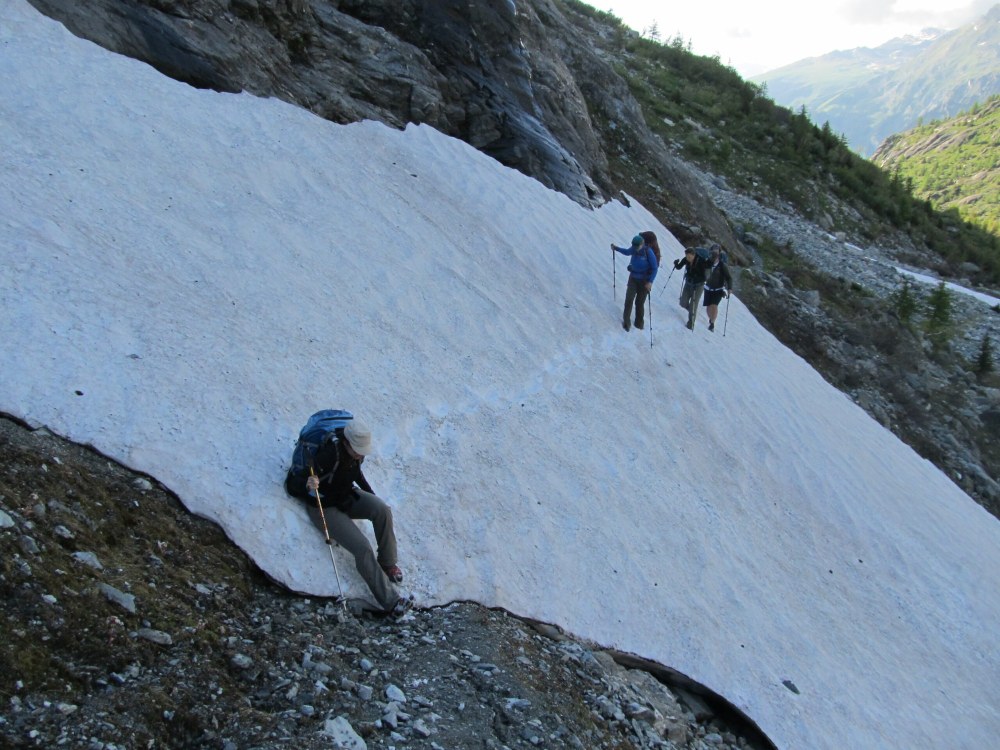Winter arrived early in the Alps this year: on Friday, September 13. While many hikers were shocked by this so-called "unusual situation," this September snowstorm was not unusual at all. These conditions forced many of our customers to end their tours early, while other customers suffered and endured miserable trail conditions.
There is a lot of bad information and advice out there about the hiking season in the Alps. It’s time to clear that up.
First, let’s address a couple of the reasons why there is so much misleading information:
- In today’s world, a lot of hikers rely on blogs to get information about the trail they want to hike. These blogs are excellent resources; we read them too. But they fall short when it comes to seasonal advice. Most bloggers have only been on a particular trail in a particular region once in their lives. That means, that they can only speak to the weather and conditions during the one year they were on the trail. They don’t have any experience with seasonal conditions over multiple years, meaning they simply don’t have the big picture. We don’t discourage referring to blogs as a resource for information, but please don’t take their advice about the seasons (and yes, we do happen to be writing about this on a blog). Two reliable blogs that have experience in the Alps in various seasons and years are Moon & Honey Travel and Crave the Planet.
- Most of the huts in the Alps open in mid-June and close in mid- to late-September, leading many hikers to believe that the opening season of the huts reflects hut-to-hut hiking season. But many of the huts in the Alps gain their main source of revenue from day visitors, not from overnight visitors. The opening season of the huts reflects when the trail is clear from the valley to the hut, not when the trail is clear getting over the pass to the next hut. The high passes have much shorter seasons than the lower-elevation trails do, and therefore, hut-to-hut hiking season is shorter than the hut operating season.
You might be wondering why you should believe what we are saying, especially since it conflicts with a lot of the information you've already come across. Here’s why:
We have years of experience sending customers out on the trail and supporting them during their treks. We see the weather from year to year and understand how it impacts our customers’ hiking itineraries because we are supporting them with itinerary adjustments. Every member of the Alpenventures team has extensive experience in the Alps during, and outside of, the summer season.
So, when is the best time to hike in the Alps?
You are most likely to have favorable conditions for your hike between mid-July and the end of August.
If you want to avoid the crowds, there are many other factors to take into account. But the short answer is… if you want to avoid the crowds, choose a less-crowded tour that you can do during the recommended season and that you have a high probability of being able to complete, rather than taking chances with the conditions during the so-called “shoulder season” in June and September.
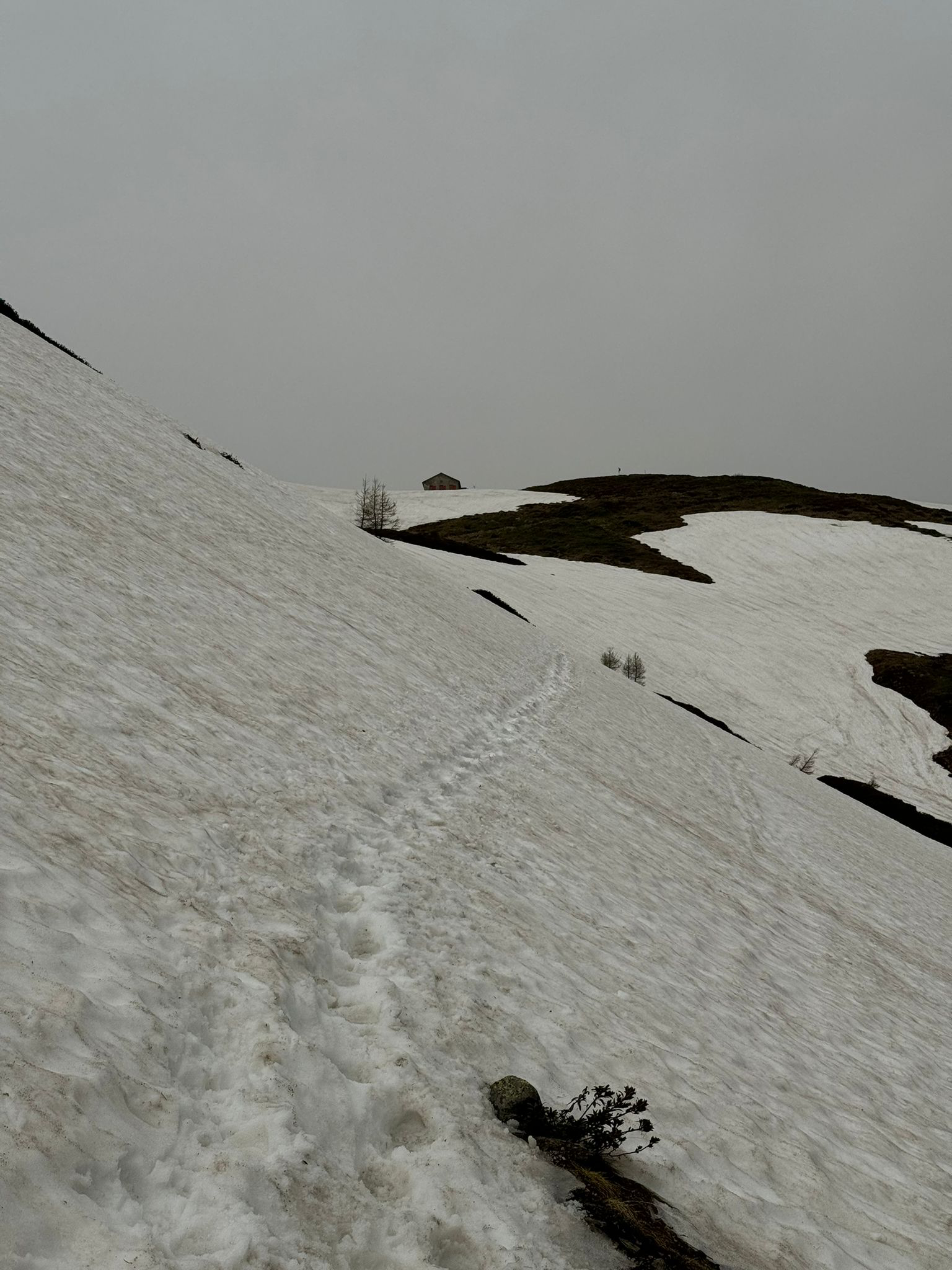
When to consider your hut-to-hut hike in the Alps
Early June
There are almost no options for a hut-to-hut hike in the Alps before mid-June. Most passes in the Alps are still covered with snow, and hiking conditions will be challenging. Crossing passes at this time of year requires mountaineering experience, the ability to evaluate avalanche danger, and carrying (as well as knowing how to use) mountaineering equipment such as crampons, an ice axe, a helmet, and possibly avalanche recovery gear.
Before June, many bridges that cross streams are not yet installed, and those waterways run high due to the snowmelt. They can be challenging to cross. The options that are available to most hikers are at low elevations. We recommend either staying in a hotel and doing day hikes from the valley under the advice of the local tourist information office that can tell you about current conditions, or following our Hut to Hut in Switzerland Light itineraries. Much of the tourist infrastructure, such as buses and lifts, may not be operating at this time.
Late June
Huts are open and most routes from the valleys to the huts are clear of snow. Problematic snow may still remain on the passes and at high elevations, and in some years, it may be necessary to bypass certain sections of trail using transportation (which is not convenient and is usually expensive).
Even if the passes are clear in time for your hike, they usually clear at the very last minute, and June hikers always have a couple of stressful weeks leading up to their hike as they check webcams and eagerly wait for the snow to melt in time for their hike. In addition, many bridges that cross streams may not yet be installed, and those waterways run high due to the snowmelt. These bridges get installed after enough snow has melted and there is no longer risk of snow slide that would damage the bridge. The installation happens at a different time each year.
Almost every year, it is not possible to predict what trails are going to be like in June until one or two weeks before. This is true even after a winter with low snowfall, as large dumps of late spring snow often impact June hiking conditions. Some of the buses, lifts, and other tourism infrastructure don’t start operating until late June or early July, and bus timetables are not available in advance, which makes planning difficult.
June is a risky time to plan a hut-to-hut hike in the Alps. We estimate that every one of two years there is problematic snow that can be disruptive to hiking itineraries through the end of June. That’s a 50% chance. (Most of the photos below indicate June trail conditions.)
possible June trail conditions
Note: The trails do not look like this every June.
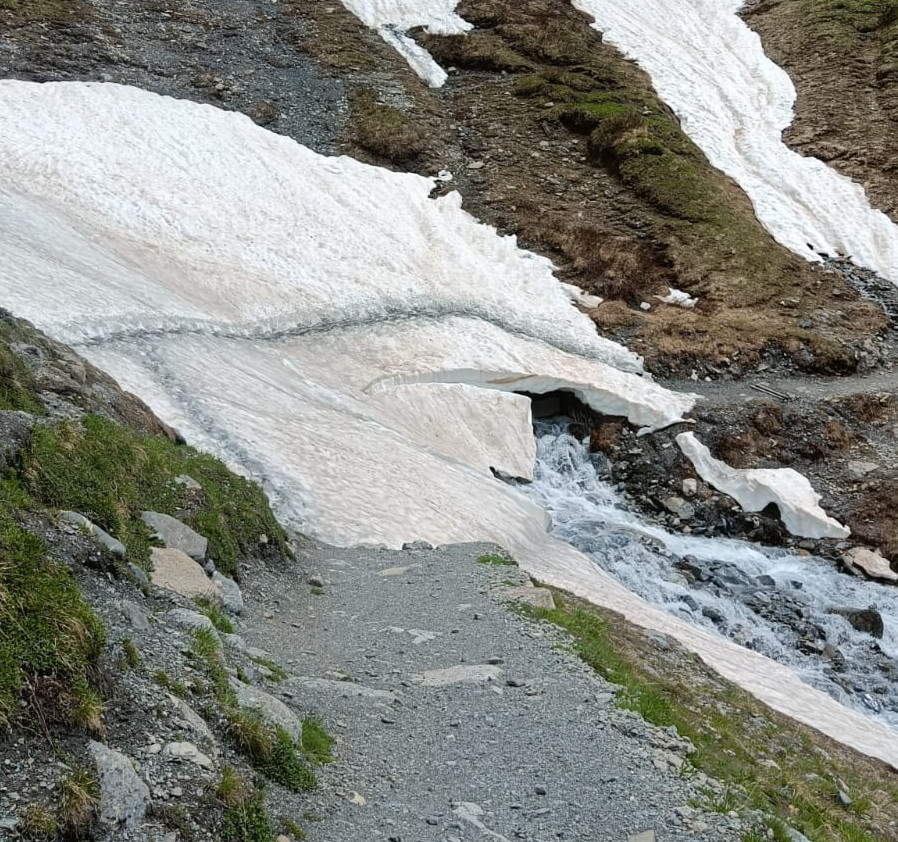 A dangerous stream-crossing, because the bridge is not yet installed, on the TMB on June 18, 2024.
A dangerous stream-crossing, because the bridge is not yet installed, on the TMB on June 18, 2024.

Crossing a steep snowfield on the Tour des Combins on June 30, 2013.
 Navigating a lot of snow on the Tour du Mont Blanc, approaching Col de la Croix du Bonhomme on June 11, 2024.
Navigating a lot of snow on the Tour du Mont Blanc, approaching Col de la Croix du Bonhomme on June 11, 2024.
 Struggling through steep and relentless snowfields on June 30, 2013.
Struggling through steep and relentless snowfields on June 30, 2013.
 Crossing the Grand Col Ferret on the Tour du Mont Blanc on June 13, 2024.
Crossing the Grand Col Ferret on the Tour du Mont Blanc on June 13, 2024.
July and August
Problematic snow can remain on the route through the first week of July, but it is less likely than in June. The risk of the bridges not yet being installed carries through into the first week or so of July. Every five years or so, hiking itineraries in the first week of July experience disruptions due to the snow.
Beginning the second week of July, trails are almost always clear. Summer settles in and days are usually mostly sunny with an afternoon thunderstorm or two. These thunderstorms usually last only 30 minutes to an hour and rarely interfere with hiking itineraries. They are not usually problematic. Of course, thunderstorm safety should be practiced. The wildflowers at the higher elevations should be popping by mid-July.
Hiking conditions during this time are often favorable, and it’s a great time to be on the trail. Mid-summer snowstorms can and do occasionally occur, but they are unlikely, and the snow doesn’t stick around for long.

Early September
The first snow of the winter usually falls in the first week of September. The snow rarely sticks around for more than a day, but the visibility can be very low, making navigation problematic, and even dangerous, at times. About every five years, the snow sticks around longer, and every seven years, the hiking season abruptly ends in early September due to a massive snowstorm.
Most days in early September are beautiful and perfect, and the thunderstorms are less frequent, but there is a higher risk of snowstorms and conditions that may prevent you from completing your hike during this time. Many hikers have incredible weather in September, but some do not. It’s simply a matter of luck. The later you push into September, the higher the risk that unfavorable conditions (usually snow, but sometimes extremely cold temperatures) can interfere with your hiking itinerary.
In early September, the wildflower season is mostly over, with the exception of brilliant bursts of fireweed that mark the end of summer. Many buses, lifts and other tourism infrastructure stop operations at the end of August or in early September.
September is a very risky time to plan a tour, and if you plan to hike in September, you need to ensure you have good gear and are comfortable navigating in low-visibility conditions. (Some of the photos below indicate September trail conditions.)
Mid- to Late-September
By mid-September, mountain huts start shutting down, and for good reason. Although there are years when autumn in the Alps is just stunning, that’s an exception and not the norm. We notice that customers who are on the trail beyond September 15 are more likely to quit their hike early due to conditions.
Late September hut-to-hut hikes are not only challenging to book (because many huts are closing) but this timing is reserved only for those with experience and gear for winter conditions.
Our Opinion on WHEN TO HIKE HUT-TO-HUT IN THE ALPS…
If the hut-to-hut hike you are planning is something you really want to do - maybe it’s been on your bucket list for years, you are buying an expensive plane ticket to get to the trail, and you have taken vacation time from work and rearranged your life to make this happen - then do your hut-to-hut hike at a time when you have the highest likelihood of being able to complete the itinerary you planned. This time is from mid-July to the end of August.
Possible September trail conditions
Note: The trails do not look like this every September.
 Low visibility and dangerous navigation conditions on the Tour of the Vanoise on September 1, 2017.
Low visibility and dangerous navigation conditions on the Tour of the Vanoise on September 1, 2017.
 The Alta Via 1 on September 13, 2024
The Alta Via 1 on September 13, 2024
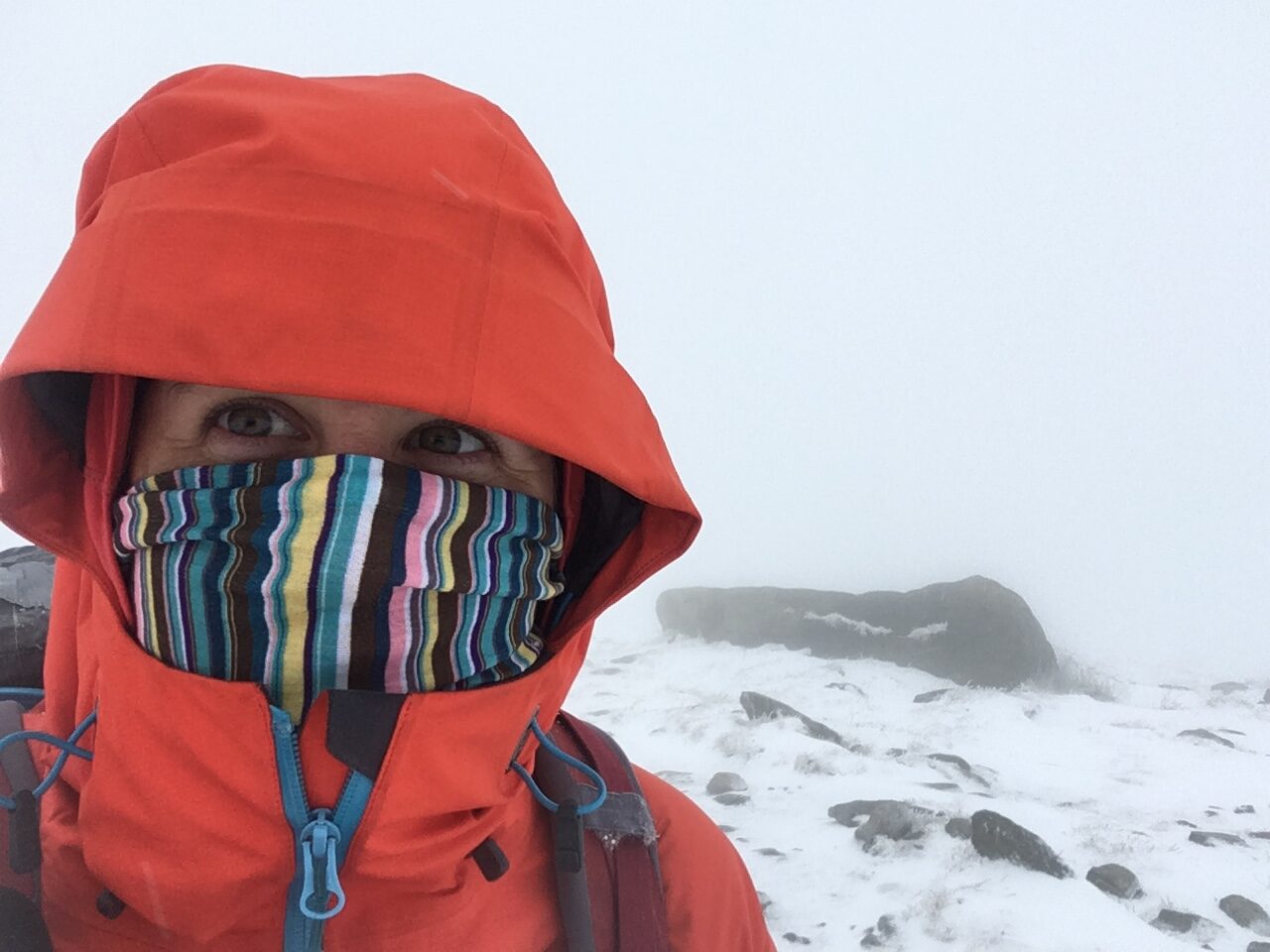 Brittany in frigid and wet conditions with low visibility on the Tour of the Vanoise on September 1, 2017.
Brittany in frigid and wet conditions with low visibility on the Tour of the Vanoise on September 1, 2017.
 The Alta Via 1 on September 13, 2024.
The Alta Via 1 on September 13, 2024.
 Refuge du Col de la Vanoise on September 1, 2017.
Refuge du Col de la Vanoise on September 1, 2017.
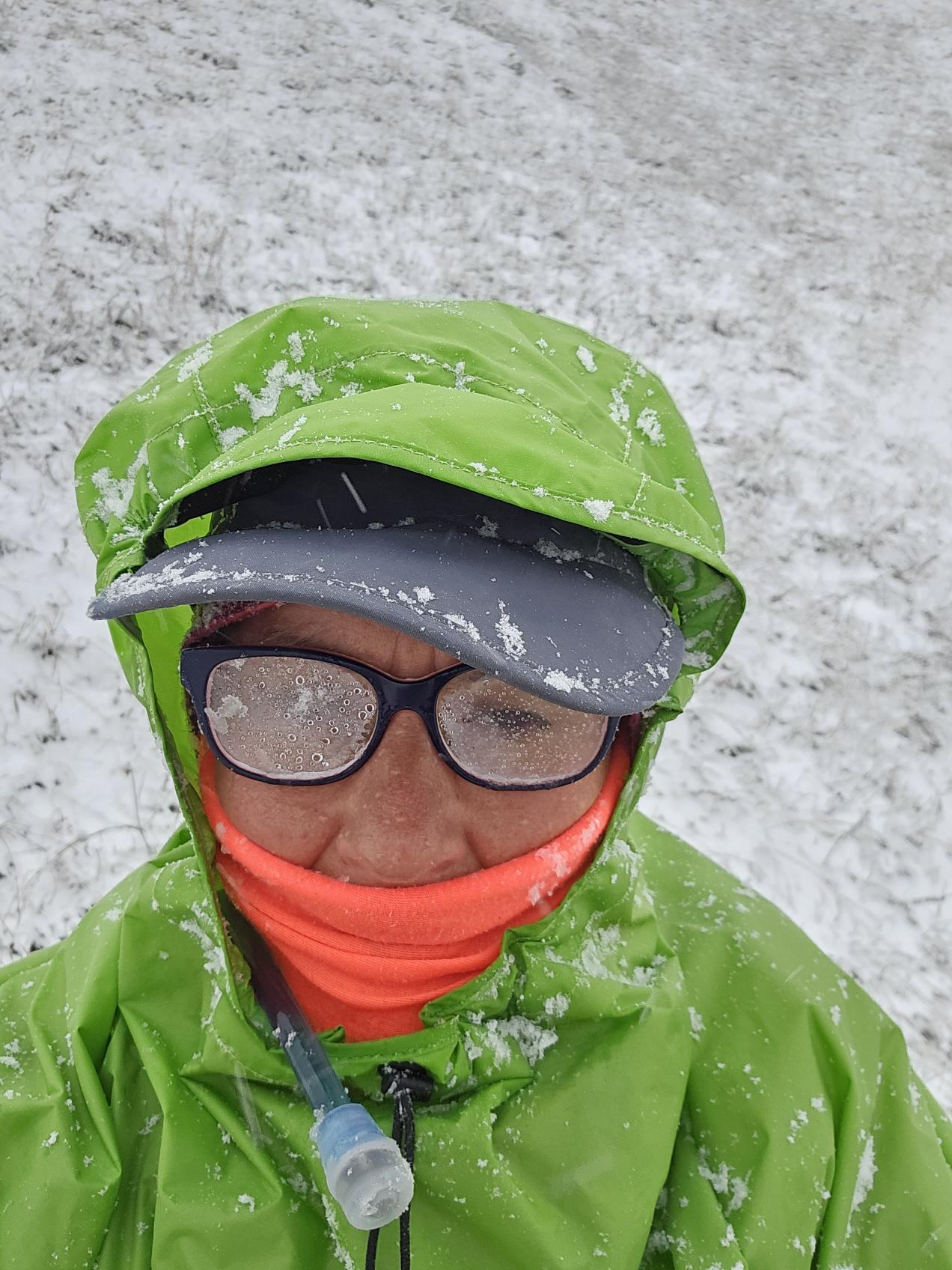 Clara toughing out unpleasant conditions on the Alta Via 1 on September 13, 2024.
Clara toughing out unpleasant conditions on the Alta Via 1 on September 13, 2024.
Avoiding crowds
We see it all the time… our customers book June and September tours on the Tour du Mont Blanc and the Alta Via 1 simply because they think they are avoiding the crowds and there will be more availability in the huts. In most cases, not only are they accepting a higher risk with the conditions, but they also won’t see any benefits. The huts on these routes book up first in June and September, and by the time the season comes, the huts will be booked full during the entire hikeable season anyway. Here are some important facts to know about crowds and hut availability:
- There will be just as many Tour du Mont Blanc and Alta Via 1 hikers in late June and early September as July and August. As long as the route is doable, the huts will be full
- Since the pandemic, the reservations at the huts along the Tour du Mont Blanc and Alta Via 1 routes fill up for June and September before they fill up for July and August
- For the past two years, August has had the most availability for last-minute reservations at the huts
- Sections along your trail that are frequented by day hikers will likely be busier in July and especially in August
- Hotels in tourist hotspots where you might stay before and after your tour are likely to be more full and more expensive in August
For most of your on-trail experience, you won’t see any benefits from a June or September tour to outweigh the risk you are taking with the conditions. For travel before and after your tour, and sections of trail that are frequented by day hikers, there are some benefits to hiking in June and September. But these benefits do not outweigh the risks.
So, why are reservations at the huts filling up first in June and September now? We credit this to bloggers and authors who have recommended June and September hiking as a pro-tip, to the extent that the trend flip-flopped.
If your goal is to avoid crowds, then we strongly urge you to consider a hut-to-hut route other than the Tour du Mont Blanc or the Alta Via 1. The Alps have an extensive mountain hut network and the hut-to-hut route possibilities are endless. There is no reason why you must limit yourself to the same route that tens of thousands of others are doing, and the locals are avoiding. Here are some other great hut-to-hut hikes that are less crowded:
- Tour of the Vanoise
- Culinary Delight Hut Hiking Tour
- Tour des Combins (for experienced and fit hikers)
- Hut to Hut Light in the Austrian Alps
- Hut to Hut in Switzerland
In summary, you should be careful who you are getting your seasonal hiking advice from. Are they really familiar with trail conditions at different times of year spread out over a span of many years, or do they only know the conditions from one year?
In our opinion, mid-July to the end of August is the best season for hut-to-hut hiking in the Alps. If you want to hike in late June or early September, you should be an experienced hiker, prepared with equipment for both summer and winter conditions, confident in navigating in snow and low visibility, and able to make adjustments to your planned route. These adjustments can often be expensive, so travel insurance is a must.
For hikes any time of year in the Alps, it is important to check the weather forecast daily beginning nine to 14 days before your tour, using multiple resources such as Weatherpro, Bergfex, Meteoblue, and mountain-forecast.com. For packing purposes, you can also check the forecast up to a month in advance, as well as researching average temperatures and average rainfall for the time of year you will be on the trail. One of the most important elements of mountain safety is the ability to stay warm and dry. This requires adequate rain protection for you and the gear inside your backpack, as well as sufficient warm layers.
If you do choose a June or September hike, do it for valid reasons, such as your own schedule or other travel plans, and not based on misleading information circulating social media and the internet.
 Brittany Haas
Brittany Haas
